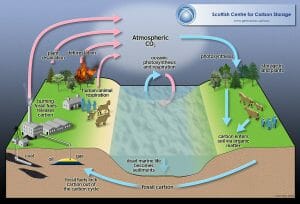The Earths producer organisms are primarily its green terrestrial plants and the algae in the oceans. These plants use the carbon from carbon dioxide to create sugar molecules through the process of photosynthesis. Terrestrial plants get their carbon dioxide from the atmosphere while marine plants get it from carbonic acid, the dissolved form of carbon dioxide. Plants feed themselves (autotrophs) with the sugars they make and store excess sugar in the form of glucose, proteins, fats and polysaccharides.
When herbivores and omnivores eat plants (and when another animal eats them), the carbon-containing molecules are stored in their bodies or broken down and used to make energy through the process of cellular respiration. One of the products of respiration is carbon dioxide which is released and re-enters the atmosphere and the oceans. This constant back and forth exchange of carbon between plants and the animals that eat them is a major part of the carbon cycle on Earth.

The image above shows the carbon cycle on earth including the important roles that animal/human respiration and photosynthesis play.
References
- OpenStax, Biology. OpenStax. May 20, 2013. http://cnx.org/content/col11448/latest/
